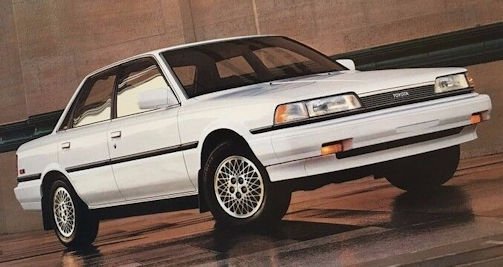Toyota Camry 2nd generation (CV20 / SV21 / VZV21)
 |
|
|
Production period: |
1986 to 1991 |
|
Body versions: |
sedan, station wagon |
|
Engines: |
Gasoline :1.8-2.5 litres(64-118 kW) |
|
Length: |
4520 mm |
|
Width: |
1690 mm |
|
Height: |
1374 mm |
|
Wheelbase: |
2600 mm |
|
Curb weight: |
1240 kg |
The second-generation Camry introduced the internal designations CV20, SV 21 and VZV 21 and came in the fall of 1986 on the market. It was offered again as a four-door notchback sedan, a hatchback variant (Lift back), however, there was no longer. As a replacement for a combi appeared in the program for the first time.
In Europe, the Camry replaced since the fall of 1985 there no longer available Toyota Cressida, while it was offered in parallel to this in North America. The body shape had been smoothed and roundish. The drag coefficient (cw value) reached the size of 0.35. The sedan had a length of 4500 mm, a width of 1712 mm and a height of 1365 mm, the station wagon had the dimensions 4625 mm / 1712 mm / 1375 mm. The car was as a GLi with catalyst and 1984 cc displacement with an output of 89 kW (121 hp) - initially without a catalyst with 94 kW (128 hp), XL turbo diesel with 1981 cc displacement and 62 kW (84 hp) as well offered as V6 GXi Kat with 2490 cc and 118 kW (161 hp).
In North America, this Camry was very successful and provided the basis for the end of 1989 offered Lexus ES . Likewise, he was also the basis for the end of 1989 offered Holden Apollo. In the US, the Camry served as the basis for the Lexus ES. In Austria, the 121 hp limousine was also offered with four-wheel drive. In Switzerland, the station wagon (or sports wagon as he was called in Switzerland) was available with four-wheel drive and a power of 117 hp.
The models 466 (saloon closed, models 001/9, 002/0, 003/2, 004/4, 005/6 and 006/8) and 469 (station wagon) were closed at the factory (types 001/2, 002/4, 003 / 6) equipped with a regulated catalyst, but on the day of its first registration not yet marked accordingly in the vehicle documents, as the key OTTO / GKAT no. 51 was not included in the list of drive types. A corresponding portage led to the classification in a more favourable tax class of vehicle tax.
